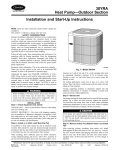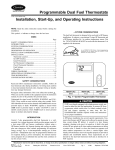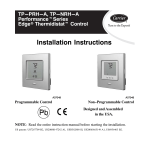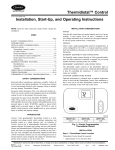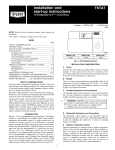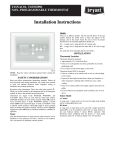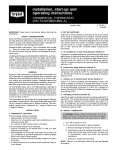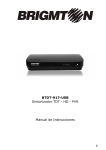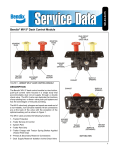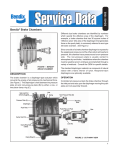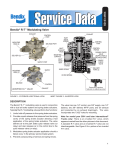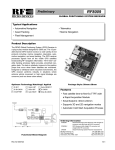Download Carrier Programmable Dual Fuel Thermostats Operating instructions
Transcript
Programmable Dual Fuel Thermostats Installation, Start-Up, and Operating Instructions NOTE: Read the entire instruction manual before starting the installation. This symbol → indicates a change since the last issue. SAFETY CONSIDERATIONS Read and follow manufacturer instructions carefully. Follow all local electrical codes during installation. All wiring must conform to local and national electrical codes. Improper wiring or installation may damage thermostat. Recognize safety information. This is the safety-alert symbol . When you see this symbol on the equipment and in the instruction manual, be alert to the potential for personal injury. Understand the signal words DANGER, WARNING, and CAUTION. These words are used with the safety-alert symbol. DANGER identifies the most serious hazards which will result in severe personal injury or death. WARNING signifies a hazard which could result in personal injury or death. CAUTION is used to identify unsafe practices which would result in minor personal injury or product and property damage. INTRODUCTION Carrier’s 7-day programmable dual fuel thermostat is a wallmounted, low-voltage thermostat which provides proper control of a heat pump (HP) and furnace combination without using a HP/furnace interface kit. Separate heating and cooling setpoints, plus auto changeover allow setback programming for maximum energy savings. Up to 4 time/temperature settings per 24 hour period for 7 independent days may be programmed. Batteries are not required; during a power interruption, the internal memory stores programs for an unlimited time and the clock continues to run for at least 72 hrs. SYSTEM CONSIDERATIONS The dual fuel thermostat is designed to be used only in HP/furnace installations. It replaces a conventional 2-stage HP thermostat and a HP/furnace interface kit. An outdoor temperature sensor, Part No. TSTATCCSEN01 MUST be used with this thermostat. It is not supplied with thermostat. If HP is not already equipped with a high-pressure switch, one must be added for dual fuel applications. It protects HP from overpressure which would occur if a failure resulted in both HP and furnace operating at same time. Kit No. KSAHI0201HPS includes required switch and instructions for its proper installation. A HP/furnace installation has several special requirements. Foremost is that furnace and HP must not be allowed to operate at same time, except during HP defrost. A second is to have furnace complete a heating cycle once it is turned on. A third is the need to have HP not operate at all when outdoor temperatures are below ® A94134 HEIGHT (IN.) 4-1/4 WIDTH (IN.) 7-1/2 DEPTH (IN.) 1-3/8 Fig. 1—Carrier Programmable Thermostat a certain value. Finally, HP and furnace must work together properly to provide an efficient and comfortable defrost. These requirements are addressed by the dual fuel thermostat itself and an interface kit is NOT required. APPLICATION The dual fuel thermostat is designed for the following applications: 1-stage 1-stage 2-stage 2-stage cool, cool, cool, cool, 2-stage 3-stage 3-stage 4-stage heat: heat: heat: heat: 1-speed 1-speed 2-speed 2-speed HP HP HP HP with with with with 1-stage 2-stage 1-stage 2-stage furnace furnace furnace furnace* *This combination must use furnace algorithm to control furnace staging. As outdoor temperature decreases, heat loss increases and HP capacity decreases. There is a temperature below which HP will not be able to ″keep up″ and furnace will be required to maintain temperature. This is the thermal balance point. There is also an economic balance point, determined by relative costs of fuel and electricity, below which the furnace is the most cost effective and above which the HP is the most cost effective. Finally there may be a comfort balance point below which leaving air temperature of HP is not comfortable, even if HP has sufficient capacity to keep structure warm. Any of these balance points may be the determining factor in the selection of an outdoor temperature below which HP will be turned off and only furnace allowed to operate. This balance point temperature is entered into thermostat by installer. Outdoor temperatures from 15˚F to 55˚F may be selected. Instructions for entering this selection is covered in the section: Balance Point—Value Selection. When outdoor temperature is below selected balance point temperature, furnace is used exclusively to supply heat. Manufacturer reserves the right to discontinue, or change at any time, specifications or designs without notice and without incurring obligations. Book 1 4 PC 101 Catalog No. 92-33TS-TA35C Printed in U.S.A. Form TSTAT-9SI Pg 1 2-96 Replaces: TSTAT-6SI Tab misc. misc. When outdoor temperature is above both selected balance point temperature and thermal balance point, HP will be used exclusively, because it will have sufficient capacity to satisfy load. Y1/W2 turns on compressor at low speed and may also adjust blower speed for low-speed HP operation. If selection of balance point temperature is such that it is below thermal balance point, all operation between these 2 temperatures will be part HP and part furnace. A heating cycle will begin with HP operation. Because HP has insufficient capacity, structure temperature will slowly fall. After a time, thermostat will issue next stage call, turning off HP and turning on furnace. Furnace will operate until thermostat is completely satisfied at which time furnace will turn off. The next heating cycle will begin with HP and cycle will repeat. High-Speed HP heating: Y/Y2 is added to low-speed HP heating call to operate compressor at high speed and adjust blower for high-speed HP operation. Heating Operation—Single-Stage Furnace W/W1 causes furnace to operate. Furnace controls its own blower at heating speed. Heating Operation—Two-Stage Furnace—Thermostat Control Low fire: W/W1 causes furnace to operate at low fire. Furnace controls its own blower at low heating speed. This operating mode is acceptable as long as selected balance point temperature is not too far below thermal balance point. This thermostat has no ″droop″ between stages, and structure will not cool significantly below setpoint before furnace comes on. However, there is a 15-minute timer which requires HP to operate for 15 minutes before furnace comes on. If balance point temperature is set too far below thermal balance point, the temperature loss during this 15 minute period could be uncomfortable. High fire: Y1/W2 is added to low-fire heating call to operate furnace in high-fire mode. Furnace controls its own blower at high heating speed. Heating Operation—Two-Stage Furnace—Algorithm Control W/W1 causes furnace to operate. Based on amount of time it is required to be on, it determines when to operate at low fire and when to operate at high fire. It controls its own blower at proper speed. Defrost Operation For most installations balance point temperature setting should be in the range of 25˚F to 45˚F. If set too high, HP will not be used enough and its advantages not realized. If set too low, structure temperature loss during HP operation will become uncomfortable. In case of 2-speed heat pumps or 2-stage furnaces, thermostat will start equipment at low capacity and if this is not sufficient, will advance to higher capacity. If load demand is between low and high capacities, it will cycle between these 2 stages, i.e. between low and high heat pump speeds or between furnace low and high fire. However, once operation proceeds from HP to furnace, it will NOT cycle directly back to HP. Furnace will remain on until all stages of thermostat are satisfied. A unique feature of this thermostat is that a defrost cycle, once started, will always be completed. This is true even if thermostat is satisfied during defrost. The result is that a heating cycle never begins with an uncompleted defrost and its associated ″cold blow″. During operation of HP in heating mode, HP itself determines when a defrost is necessary. It initiates defrost by energizing its O and W wires. The signal on the O wire switches HP from heating to cooling mode and W signal starts furnace. Thermostat monitors this action by sensing the signal (which it did not create) on the O line. It responds by turning on its W outputs (both if 2-stage furnace) to hold furnace on high fire. At completion of defrost, indicated by removal of signal from HP on O wire, thermostat does 1 of 2 things. If it is satisfied, it turns off all Y, G, and W outputs which results in all equipment off. If not satisfied, it will turn off Y and G, leaving W on until it becomes satisfied. In this way it assures that furnace will be used to satisfy a heat demand existing after a defrost cycle is completed. Emergency Heat DESCRIPTION OF OPERATION Cooling Operation—Single Speed HP cooling: O/W2 energizes reversing valve to select cooling operation. G energizes furnace blower. Y/Y2 energizes compressor and selects high blower speed at furnace. When cooling demand is satisfied, G and Y/Y2 are de-energized. O/W2 will remain on to minimize cycling of reversing valve. It will turn off only when a call for heat occurs. If EHEAT mode is selected at thermostat, all heating will be done by furnace. Continuous Fan Cooling Operation—Two Speed Low-speed HP cooling: O/W2 energizes reversing valve to select cooling operation. G energizes furnace blower. Y1/W2 energizes compressor at low speed and may determine furnace blower speed. If FAN ON mode in selected, thermostat energizes G terminal, which causes fan to operate when both heating and cooling are off. Staging Sequence—Heating Depending on whether HP is single or 2 speed and whether furnace is single or 2 stage, the staging of thermostat outputs with increasing demand varies. Table 1 shows the heating staging sequence for all 4 possible combinations of single- and multi-stage equipment. Note that thermostat itself has a maximum of 3 heating stages. Note also that at outdoor temperatures below selected balance point temperature no HP operation is allowed. As discussed earlier, once furnace is turned on, it remains on to satisfy all demand. High-speed HP cooling: Y/Y2 is added to low-speed cooling call to operate compressor at high speed and increase blower speed. Heating Operation—Single-Speed HP HP heating: O/W2 remains off to select heating operation. G turns on furnace blower. Y/Y2 energizes compressor and increases furnace blower speed. A ″freeze protect″ feature is built into the dual fuel thermostat. If indoor temperature sensor fails, and thermostat is in HEAT or AUTO mode, heat will be cycled when outdoor temperature is below 50˚F. The amount of heat supplied will increase as outdoor temperature decreases, keeping structure from freezing. Heating Operation—Two-Speed HP Low-Speed HP heating: O/W2 remains off to select heating operation. G turns on furnace blower. 2 Table 1—Heating Stages WIRING DIAGRAM SYSTEM TYPE Fig. 2 1-speed HP 1-stage furnace Fig. 3 1-speed HP 2-stage furnace Fig. 4 2-speed HP 1-stage furnace Fig. 5 2-speed HP 2-stage furnace OUTDOOR TEMP/ BAL. PT. TEMP Above Below Above Below Above Below Above Below INSTALLATION NOTE: All TSTAT models do not have batteries and are not ″power stealing″. They do require 24VAC (R and C terminals) to be connected for proper operation. Thermostat will not operate without these 2 connections. STAGE 1 STAGE 2 STAGE 3 HP Furnace HP Furnace Lo HP Lo Furnace HP Lo Furnace Lo or Hi Furnace — Furnace Lo Furnace Hi HP Hi — HP Hi — — — Furnace Hi — Furnace — Furnace Lo or Hi — disconnected, cooling is allowed regardless of switch setting. → TO SET: OFF—cooling is disabled at outdoor temperatures below 55˚F. ON—cooling is allowed at outdoor temperatures below 55˚F. Switch D - Select Single-Speed or 2-Speed HP Step 1—Thermostat Location Use this switch to tell dual fuel thermostat whether it is controlling a single- or 2-speed HP. It must be set properly. TO SET: OFF—for single-speed HP. ON—for 2-speed HP. Thermostat should be mounted: • • Approximately 5 ft (1.5m) from floor. Close to or in a frequently used room, preferably on an inside partitioning wall. • On a section of wall without pipes or duct work. • In a location where the outdoor temperature sensor wires can be routed to thermostat location. It is acceptable to use 2 separate wires in thermostat cable to connect outdoor sensor. These wires may be connected at furnace to another pair continuing to outdoor heat pump. The outdoor sensor may then be mounted and connected in vicinity of heat pump, but be sure it is not located in direct sunlight. Thermostat should NOT be mounted: → Step 3—Install Thermostat Before installing thermostat, turn off all power to unit. There may be more than 1 power disconnect. Electrical shock can cause personal injury or death. 1. Turn OFF all power to unit. • Close to a window, on an outside wall, or next to a door leading to the outside. • Exposed to direct light and heat from a lamp, sun, fireplace, or other temperature-radiating object which may cause a false reading. • Close to or in direct airflow from supply registers and return-air grilles. • In areas with poor air circulation, such as behind a door or in an alcove. Step 2—Set DIP Switches 2. If an existing thermostat is being replaced: a. Remove existing thermostat from wall. b. Disconnect wires from existing thermostat, 1 at a time. Be careful not to allow wires to fall back into the wall. c. As each wire is disconnected, record wire color and terminal marking. d. Discard or recycle old thermostat. NOTE: Mercury is a hazardous waste and MUST be disposed of properly. There are 4 small switches on the back of the circuit board which must be set by the installer. The ON position is indicated by small letters on the switch itself. Ignore numbers 1-4 on the switch. The switch designation (A through D) is on the circuit board next to the switch. To change a switch position use the corner of a small screwdriver to slide it between on and off. Make these selections BEFORE installing the thermostat--it is much easier. 3. Open thermostat rear door (mounting base) to expose mounting holes. The base can be removed to simplify mounting. Snap apart carefully at hinge to separate mounting base from remainder of thermostat. This switch must be in OFF position in all dual fuel applications. DO NOT turn ON. 4. Route thermostat wires through large hole in mounting base. Level mounting base against wall (for aesthetic value only—thermostat need not be leveled for proper operation) and mark wall through 2 mounting holes. Switch B - Setback Recovery 5. Drill two 3/16-in. mounting holes in wall where marked. Selects between normal and smart recovery from setback. Normal recovery changes to the new setpoint at the programmed time. Smart recovery, which is active in heating mode only, starts earlier and adjusts the setpoint slowly so that room temperature will arrive at the programmed temperature at the programmed time. TO SET: OFF—for smart recovery. This is the factory default. ON—for normal recovery. 6. Secure mounting base to wall with 2 screws and anchors provided, (additional anchoring holes available for more secure mounting if needed) making sure all wires extend through hole in mounting base. Switch A - Not Used in Dual Fuel Thermostats Switch C - Disable Low-Ambient Cooling 7. Adjust length and routing of each wire to reach proper terminal and connector block on mounting base with 1/4 in. of extra wire. Strip only 1/4 in. of insulation from each wire to prevent adjacent wires from shorting together when connected. Use to allow or prevent cooling operation below an outdoor temperature of 55˚F. Prevention of cooling below 55˚F adds to compressor reliability. If outdoor temperature sensor fails or is 8. Match and connect equipment wires to proper terminals of the connector blocks. (See Fig. 2 through 5.) Both R and C must be connected for proper thermostat operation. 3 Clean Filter Timer—Selection and Adjustment Select hours of blower operation before CLEAN FILTER icon is displayed. Timer accumulates total blower hours. Selection can range from 400 to 3600 hours or can be turned off. Factory default is 2 (800 hours). Recommended selections are: disposable filter—400 to 800 hours, media filter—1200 to 1600 hours, or electronic air cleaner—1600 to 2400 hours of blower operation. TO SELECT: Improper wiring or installation may damage the thermostat. Check to make sure wiring is correct before proceeding with installation or turning on unit. 9. Push any excess wire into wall and against mounting base. Seal hole in wall to prevent air leaks. Leaks can affect operation. 10. Snap hinge back together. 1. Enter configuration mode. 11. Close thermostat assembly making sure pins on back of circuit board align with sockets in connector. 2. Press RESET FILTER button to display OF (off) or digits 1 through 9. 12. Turn ON power to unit. 3. Use up and down buttons to move between selections. Total hours equals 400 times the displayed number. OF (off) turns feature off. On power up, display shows dF for a few seconds to indicate that it is a dual fuel thermostat. 4. During the selection process, the CLEAN FILTER icon will remain on, even if OF (off) is chosen. Step 4—Set Thermostat Configuration ’Anticipator’—Adjustment Configuration options, like DIP switch settings, are intended to be selected at installation and normally are not modified by the homeowner. These options are not discussed in the homeowner’s manual and therefore must be made as part of the installation. A special procedure allows entry into the configuration mode. The thermostat will automatically exit this mode if no button is pressed for 10 seconds. While in configuration mode, 4 option choices can be made: This adjustment controls the sensitivity and cycle rate of the thermostat. Higher numbers decrease the sensitivity and slow the cycle rate. Lower numbers increase sensitivity and increase cycle rate. However, a limiting feature will not allow more than 4 equipment cycles per hour, regardless of setting. Values can range from 1 to 9. Default is 3. This default selection will provide optimum performance in nearly all installations. Try it first. Do not change setting unless there is evidence of need to do so. 1. Fahrenheit or Celsius—Selection. Unlike conventional anticipators, this setting is not to be determined by current draw. There is no need to measure, know, or compensate for current. There is also no ’droop’ with this thermostat, regardless of ’anticipator’ setting. 2. Balance point—Value Adjustment 3. Clean filter timer—Selection and Value Adjustment. 4. ’Anticipator’—Value Adjustment. This adjustment controls only sensitivity and cycle rate—up to the maximum of 4 cycles per hour. TO ADJUST: An explanation for each of these and how to enter the configuration mode follows. To enter the configuration mode: 1. Enter configuration mode. Press and hold FAN button for approximately 10 sec until room temperature disappears and display reads "--". You are now in the configuration mode. 2. Press MODE button to display value between 1 and 9. Factory default is 3. 3. Use up and down buttons to move between values. NOTE: If no button is pressed for 10 sec, thermostat will exit mode and resume normal operation. To re-enter configuration mode, FAN button must be pressed and held again. Step 5—Hold, Fan, Mode Button Operation 1. Pressing HOLD button disables the time/temperature schedule and ″holds″ the current desired temperature. When active, the HOLD annunciator is turned on. A second press of the HOLD button releases the hold feature and turns off the annunciator. While in Configuration Mode, these selections are available: Fahrenheit or Celsius—Selection Select between Fahrenheit or Celsius operation. Factory default is Fahrenheit. TO SELECT: 2. Pressing the FAN button alternately selects AUTO or ON fan operation. Fan annunciator displays the current selection. 3. Pressing the MODE button will select OFF, HEAT, COOL, AUTO, or EHEAT. Mode annunciator displays the current selection. 1. Enter configuration mode. 2. Press CHANGE DAY button to display F or C. 3. Use either up or down button to change between F and C. 4. Operation of other buttons is explained in the Homeowner’s Guide. Balance Point—Value Adjustment This adjustment allows installer to enter an outdoor temperature below which HP will not be allowed to operate. Temperatures between 15˚F and 55˚F can be selected in 5˚F steps. (Equivalent values are used when Celsius operation is selected.) A discussion of how to determine this temperature was provided earlier in the APPLICATIONS section. TO SELECT: Step 6—Check Thermostat Operation SELECT HOLD 1. Press HOLD button to select ″hold″ feature. This will prevent the setpoint from changing until the desired time/temperature schedule is entered. FAN OPERATION 1. Enter configuration mode. 2. Press COPY PREVIOUS DAY button. 1. Press FAN button, starting fan operation. Fan annunciator switches from AUTO to ON. 3. Use up or down buttons to move between 15, 20, 25, 30, 35, 40, 45, 50, and 55˚F (or equivalent values in ˚C). 2. Press FAN button, stopping fan operation. Fan annunciator switches from ON to AUTO. 4 Step 7—Select Desired Operation HEATING OPERATION 1. Press MODE button until HEAT is displayed under the mode annunciator. 1. Press FAN button to select AUTO or ON position. Fan annunciator displays current selection. 2. Make sure outdoor temperature is above balance point setting, so that HP will be enabled. 2. Press MODE button to select OFF, HEAT, COOL, or EHEAT. If AUTO is selected, first select heating desired temperature in HEAT mode and cooling desired temperature in COOL mode. Refer to homeowner’s guide. Mode annunciator displays current selection. 3. Press up button until display reads 10 degrees above room temperature. HP should begin to operate within 5 minutes. 4. Press MODE button until EHEAT is displayed. Furnace should begin to operate within 5 minutes. 3. Press up or down buttons to select desired temperature. 4. If daily cycles are to be programmed now, refer to Homeowner’s Guide for programming instructions. COOLING OPERATION 5. If thermostat has not been programmed, press HOLD button to retain desired temperature setting. 1. Press MODE button until COOL is displayed under the mode annunciator. NOTE: If HOLD button is not left ON, temperature setting will be lost until time/temperature program is entered. 2. Press down button until display reads 10 degrees below room temperature. Cooling system should begin to operate within 5 minutes. Step 8—Checklist 1. Put away tools and instruments, and clean up debris. 2. Review Homeowner’s Guide with owner. 3. Leave literature packet with owner. DUAL FUEL THERMOSTAT DUAL FUEL THERMOSTAT 24 VAC HOT SINGLE-STAGE FURNACE SINGLE-SPEED HEAT PUMP R R R G G W/W1 W COMPRESSOR Y/Y2 Y FURNACE RVS COOLING O/W2 N/A SINGLE-SPEED HEAT PUMP 24 VAC HOT R R FAN G G W/W1 W/W1 W2 Y/Y2 Y/Y2 Y FURNACE LO COMPRESSOR FAN TWO-STAGE OR VARIABLE SPEED FURNACE R O RVS COOLING O/W2 FURNACE HI Y1/W2 O W2 Y W2 Y1 24 VAC COM C RVS HEATING B O Y1/W2 C C SEE NOTES 1 AND 2 24 VAC COM C RVS HEATING B RVS SENSING L OUTDOOR S1 C C RVS SENSING S1 OUTDOOR SEE NOTE 1 SENSOR CONNECTION L SENSOR OUTDOOR TEMPERATURE S2 SENSOR CONNECTION OUTDOOR A95216 TEMPERATURE S2 Fig. 3—Two-Stage or Variable-Speed Furnace with Single-Speed Heat Pump SENSOR A95215 Fig. 2—Single-Stage Furnace with Single-Speed Heat Pump 5 DUAL FUEL THERMOSTAT SINGLE-STAGE FURNACE DUAL FUEL THERMOSTAT TWO-SPEED HEAT PUMP 24 VAC HOT R R FAN G G FURNACE W/W1 W W2 COMPRESSOR HI Y/Y2 Y Y2 R TWO-STAGE OR VARIABLE SPEED FURNACE TWO-SPEED HEAT PUMP 24 VAC HOT R R FAN G G FURNACE W/W1 W/W1 W2 COMPRESSOR HI Y/Y2 Y/Y2 Y2 R O RVS COOLING O/W2 RVS COOLING O COMPRESSOR LO Y1/W2 COMPRESSOR LO Y1 Y1/W2 W3 24 VAC COM C RVS HEATING B C C 24 VAC COM C RVS HEATING B RVS SENSING L OUTDOOR S1 SEE NOTE 1 RVS SENSING OUTDOOR SENSOR CONNECTION L S1 Y1 Y1 W2 W3 C C SEE NOTES 1 AND 2 OUTDOOR TEMPERATURE S2 O O/W2 SENSOR SENSOR CONNECTION A95217 OUTDOOR TEMPERATURE S2 SENSOR A95218 Fig. 4—Single-Stage Furnace with 2-Speed Heat Pump Fig. 5—Two-Stage or Variable-Speed Furnace with 2-Speed Heat Pump WIRING DIAGRAM NOTES: 1. Underlined letter on dual terminal indicates its usage. For Example: O/W2 means O, O/W2 means W2. Outdoor Temperature Sensor must be attached in all dual fuel installations. Jumper wire between O/W2 and L thermostat terminals MUST be present. 2. Y1 and O connections to 2-stage furnaces MAY NOT EXIST, or may be only a wire rather than a screw terminal. 6 OPERATIONAL INFORMATION Five-minute Compressor Timeguard This timer prevents the compressor from starting unless it has been off for at least 5 minutes. It can be defeated for 1 cycle by simultaneously pressing the FAN mode button and the INCREASE TEMPERATURE button. Fifteen-minute Cycle Timer This timer prevents the start of a heating or cooling cycle until at least 15 minutes after the last start of the same cycle. Its function is to assure that equipment is not cycled more than 4 times per hour. This timer is defeated for 1 cycle when the desired temperature is manually changed. It can also be defeated for 1 cycle by simultaneously pressing the FAN mode button and the INCREASE TEMPERATURE button. Fifteen-minute Staging Timer In multistage heating or cooling, this timer prevents any higher stage from turning on until the preceeding stage has been on for 15 minutes. This timer is defeated if the temperature error is greater than 5 degrees (usually due to a large change in desired temperature). Two-minute Minimum On Time In normal operation, when a stage turns on, it will not turn off for a minimum of 2 minutes. Heat/Cool Setpoints (Desired Temperatures) A minimum difference of 3 degrees is enforced between heating and cooling desired temperatures. This is done by allowing one setting to ″push″ the other, to maintain this difference. Auto Changeover When the auto changeover mode is selected, a change from heat to cool (or vice versa) will not occur until an opposite mode demand has existed for 20 minutes. If the setpoint is changed, the 20 minute requirement is deleted. Emergency Heat Mode When emergency heat mode is selected, all Y signals are locked out and W becomes energized upon a call for heat. Power On Check When AC power is first applied, all segments of display are turned on for a few seconds. Following this, the temperature display reads dF for a few seconds to indicate that it is a dual fuel thermostat. Error Codes E1 - If thermostat cannot properly read room temperature, the room temperature display will indicate E1 and thermostat will enter FREEZE PROTECT mode. When outdoor temperature is below 50˚F furnace will operate for sufficient time every half hour to keep home from freezing. The ON time is given by the formula: Minutes ON equals 15 minus (outdoor temperature in ˚F divided by 4). E2 - If the AC line voltage drops below a minimum (brownout) level, all outputs are turned off and the display indicates E2. This condition will remain for 15 seconds after proper line voltage is restored. If the AC line voltage disappears completely, the display will immediately go blank. E3 - If thermostat cannot properly read outdoor temperature E3 will be displayed in place of room temperature. The thermostat will continue to operate, but will only use furnace in HEAT mode. Auxiliary Heat Icon This icon is displayed when the furnace is operating. Smart Recovery With Smart Recovery selected, the transition out of a heating setback begins a fixed time period before the selected recovery time and gradually adjusts room temperature so that the desired temperature will be achieved at the selected recovery time. The fixed time period is 1 hr for furnaces and 1.5 hrs for heat pumps. Thermostat Troubleshooting SYMPTOM WHAT TO CHECK No LCD on temperature display Check for 24 VAC between R and C at terminal connections. Both R and C must be connected for proper operation. ″Trouble″ on temperature display Outdoor temperature sensor reading out of range. An attempt to read outdoor temperature results in ″--″ on display. Check for shorted, open, or failed outdoor temperature sensor. ″E2″ on temperature display Brownout condition or too low of voltage to thermostat. Double check wiring and check for 24 VAC between R and C. E2 will clear 15 seconds after proper voltage is restored. ″E1″ on temperature display Temperature sensor reading out of range. Check sensor for damage. If recycling power does not clear display, thermostat should be replaced. ″Clean Filter″ on temperature display After the selected number of hours of blower operation ″clean filter″ will display on LCD. This is to remind the homeowner to ″check″ filter. Press ″reset filter″ button to clear display and reset timer to 0. Cooling will not come on Select COOL mode. Decrease cooling setpoint to 10 degrees below room temperature. Simultaneously press FAN and INCREASE TEMPERATURE buttons to defeat timers. Check for 24 VAC at Y/Y2 terminal. If present, thermostat is OK and problem is with equipment or wiring. If not present, replace thermostat. Heating will not come on Select HEAT mode. Increase heating setpoint to 2 or 3 degrees (not more) above room temperature. Simultaneously press FAN and INCREASE TEMPERATURE buttons to defeat timers for 1 cycle. Check for 24 VAC at Y/Y2 terminal (single-speed HP) or Y1/W2 terminal (2-speed HP) within 10 seconds. Increase heating setpoint to 7 or 8 degrees above room temperature. Check for 24VAC at W/W1 terminal (single-speed HP) or Y/Y2 terminal (2-speed HP) within 2 minutes. After 2 minutes check for 24VAC at Y1/W2 terminal (single-speed HP) or W/W1 terminal (2-speed HP). 7 Copyright 1995 CARRIER Corp. • 7310 W. Morris St. • Indianapolis, IN 46231 tstat9si Manufacturer reserves the right to discontinue, or change at any time, specifications or designs without notice and without incurring obligations. Book 1 4 PC 101 Catalog No. 92-33TS-TA35C Printed in U.S.A. Form TSTAT-9SI Pg 8 2-96 Replaces: TSTAT-6SI Tab misc. misc.








